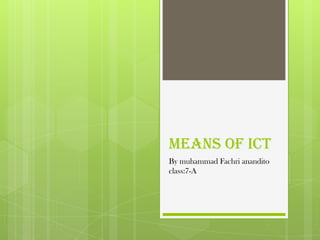
Means of ict
- 1. Means of ICT By muhammad Fachri anandito class:7-A
- 2. What is ict ? ICT is an acronym that stands for Information Communications Tecnology However, apart from explaining an acronym, there is not a universally accepted defininition of ICT? Why? Because the concepts, methods and applications involved in ICT are constantly evolving on an almost daily basis. Its difficult to keep up with the changes - they happen so fast. Lets focus on the three words behind ICT: - INFORMATION - COMMUNICATIONS - TECHNOLOGY A good way to think about ICT is to consider all the uses of digital technology that already exist to help individuals, businesses and organisations use information.
- 3. ICT is concerned with the storage, retrieval, manipulation, transmission or receipt of digital data. Importantly, it is also concerned with the way these different uses can work with each other. In business, ICT is often categorised into two broad types of product: - (1) The traditional computer-based technologies (things you can typically do on a personal computer or using computers at home or at work); and (2) The more recent, and fast-growing range of digital communication technologies (which allow people and organisations to communicate and share information digitally) Let's take a brief look at these two categories to demonstrate the kinds of products and ideas that are covered by ICT: Traditional Computer Based Technologies These types of ICT include:
- 4. Standard Office Applications - Main Examples Word processing E.g. Microsoft Word: Write letters, reports etc Spreadsheets E.g. Microsoft Excel; Analyse financial information; calculations; create forecasting models etc Database software E.g. Oracle, Microsoft SQL Server, Access; Managing data in many forms, from basic lists (e.g. customer contacts through to complex material (e.g. catalogue) Presentation software E.g. Microsoft PowerPoint; make presentations, either directly using a computer screen or data projector. Publish in digital format via email or over the Internet Desktop publishing
- 5. Graphics software E.g Adobe Photoshop and Illustrator; create and edit images such as logos, drawings or pictures for use in DTP, web sites or other publications Specialist Applications - Examples (there are many!) Accounting package E.g. Sage, Oracle; Manage an organisation's accounts including revenues/sales, purchases, bank accounts etc. A wide range of systems is available ranging from basic packages suitable for small businesses through to sophisticated ones aimed at multinational companies. Computer Aided Design Computer Aided Design (CAD) is the use of computers to assist the design process. Specialised CAD programs exist for many types of design: architectural, engineering, electronics, roadways Customer Relations Management (CRM) Software that allows businesses to better understand their customers by collecting and analysing data on them such as their product preferences, buying habits etc. Often linked to software applications that run call centres and loyalty cards for example.
- 6. Traditional Computer Based Technologies The C part of ICT refers to the communication of data by electronic means, usually over some distance. This is often achieved via networks of sending and receiving equipment, wires and satellite links. The technologies involved in communication tend to be complex. You certainly don't need to understand them for your ICT course. However, there are aspects of digital communications that you needs to be aware of. These relate primarily to the types of network and the ways of connecting to the Internet. Let's look at these two briefly (further revision notes provide much more detail to support your study).
- 7. Internal networks Usually referred to as a local area network (LAN), this involves linking a number of hardware items (input and output devices plus computer processing) together within an office or building. The aim of a LAN is to be able to share hardware facilities such as printers or scanners, software applications and data. This type of network is invaluable in the office environment where colleagues need to have access to common data or programmes.
- 8. External networks Often you need to communicate with someone outside your internal network, in this case you will need to be part of a Wide Area Network (WAN). The Internet is the ultimate WAN - it is a vast network of networks.
- 9. ICT in a Broader Context Your ICT course will almost certainly cover the above examples of ICT in action, perhaps focusing on the use of key applications such as spreadsheets, databases, presentation, graphics and web design software. It will also consider the following important topics that deal with the way ICT is used and managed in an organisation: - The nature of information (the "I" in ICT); this covers topics such as the meaning and value of information; how information is controlled; the limitations of ICT; legal considerations - Management of information - this covers how data is captured, verified and stored for effective use; the manipulation, processing and distribution of information; keeping information secure; designing networks to share information - Information systems strategy - this considers how ICT can be used within a business or organisation as part of achieving goals and objectives As you can see, ICT is a broad and fast-changing subject. We hope our free study materials (revision notes, quizzes, presentations etc) will help you master IT!
